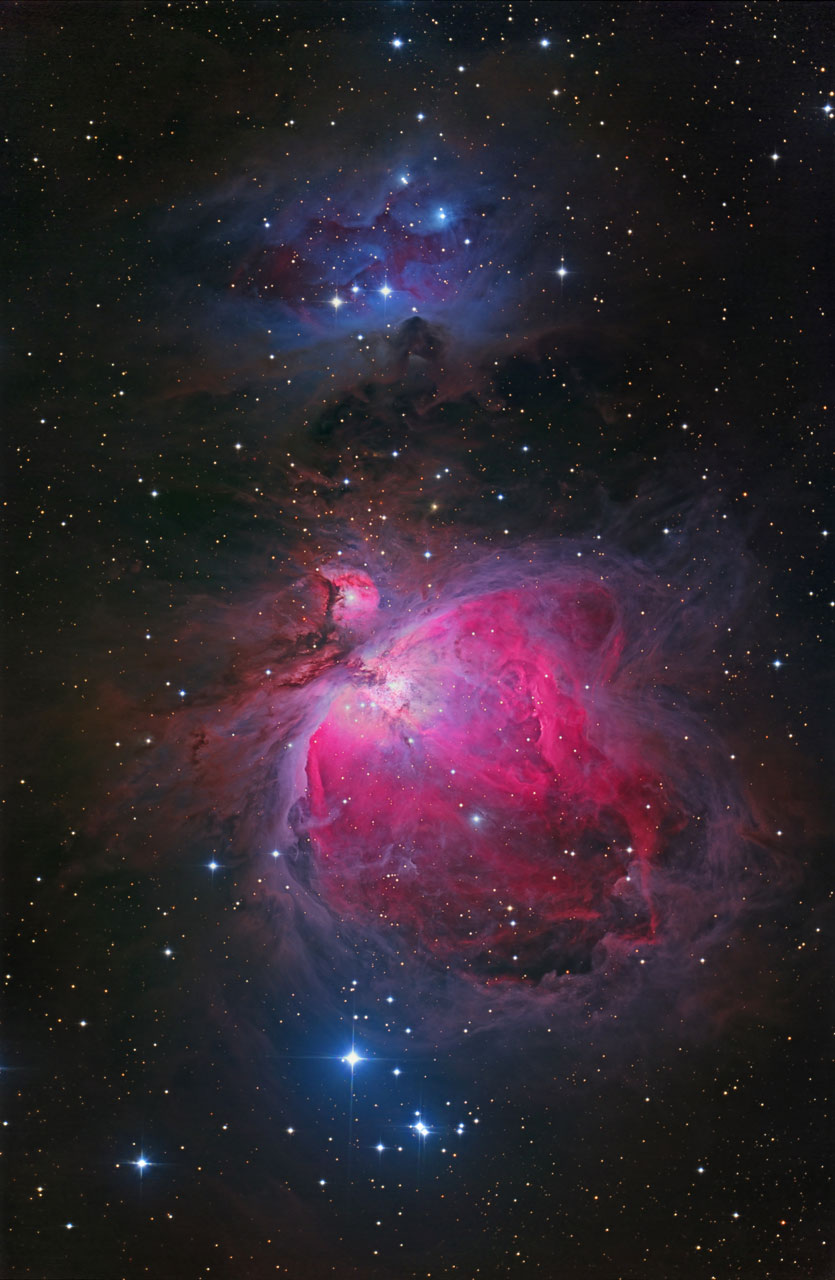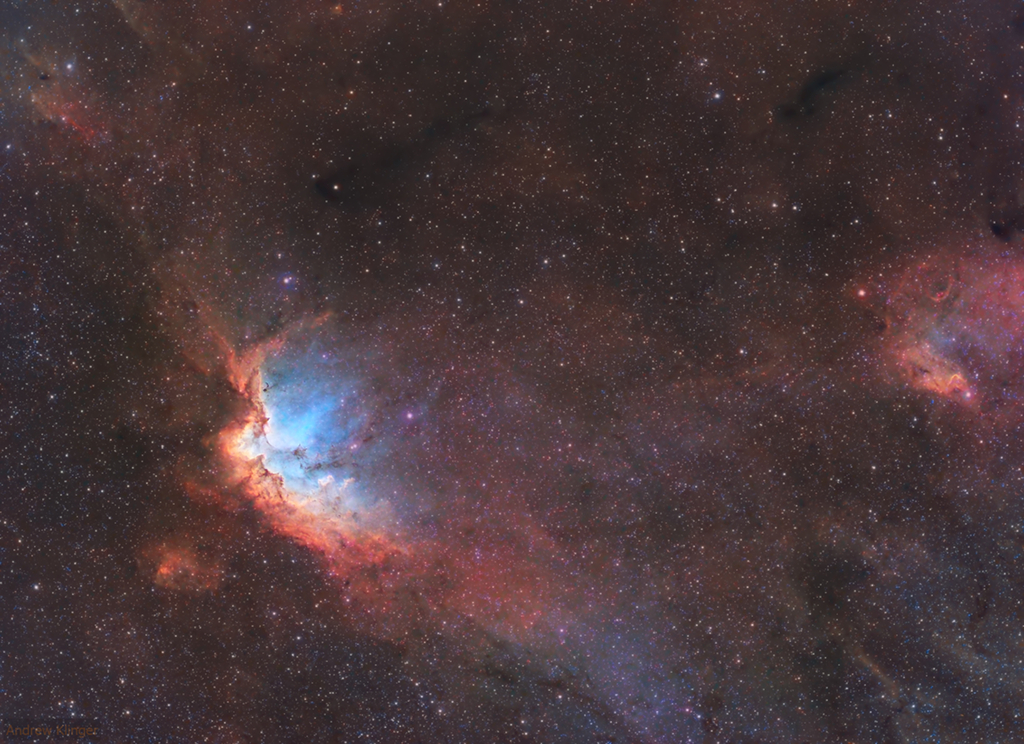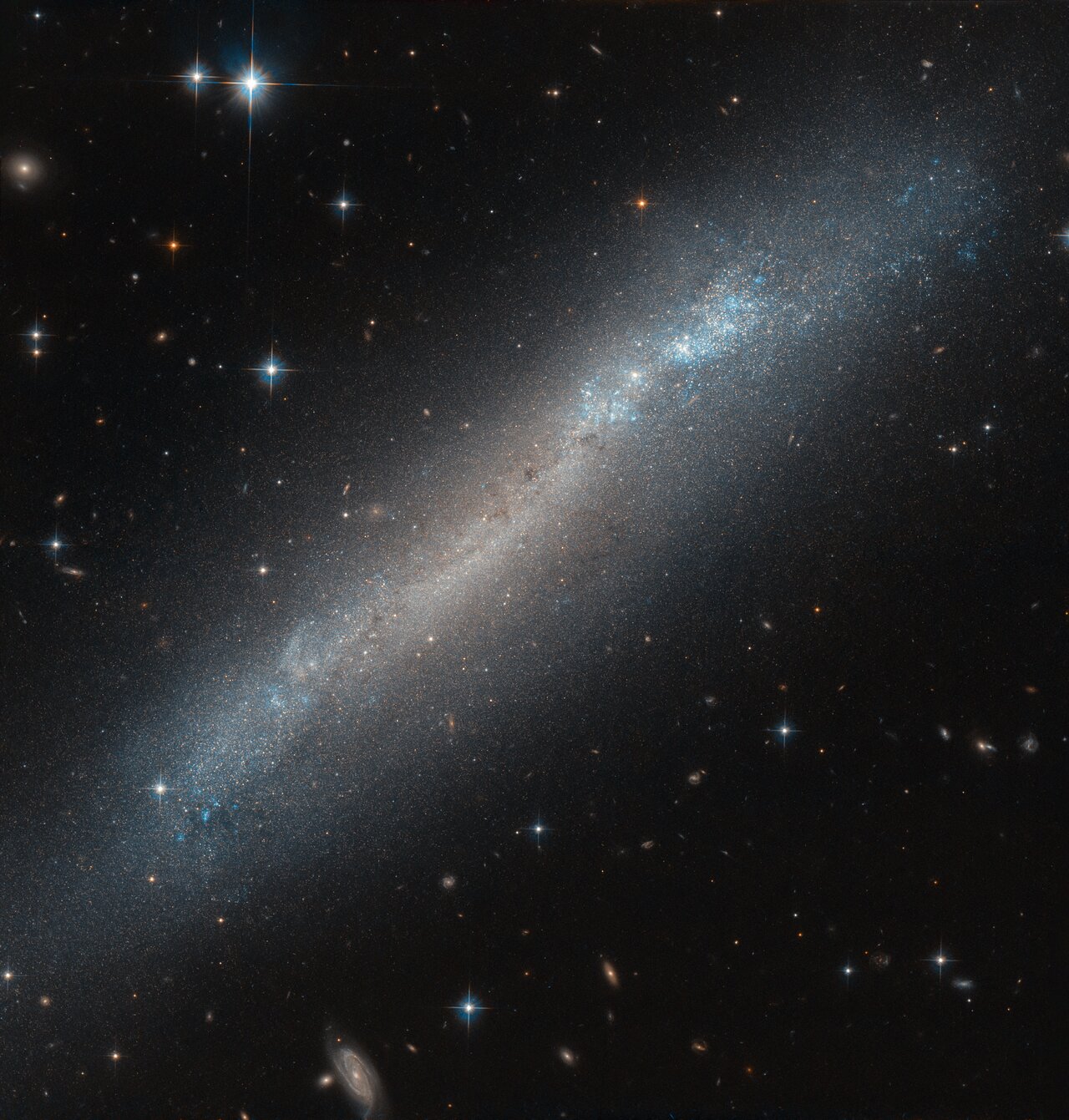Blog
The Orion Nebula (also known as Messier 42, M42, or NGC 1976) is a diffuse nebula situated in the Milky Way, being south of Orion’s Belt in the constellation of Orion. It is one of the brightest nebulae, and is visible to the naked eye in the night sky. M42 is located at a distance of 1,344 ± 20 light yearsand is the closest region of massive star formation to Earth. The M42 nebula is estimated to be 24 light years across. It has a mass of about 2,000 times that of the Sun. Older texts frequently refer to the Orion Nebula as the Great Nebula in Orion or the Great Orion Nebula.
The Orion Nebula is one of the most scrutinized and photographed objects in the night sky, and is among the most intensely studied celestial features. The nebula has revealed much about the process of how stars and planetary systems are formed from collapsing clouds of gas and dust. Astronomers have directly observed protoplanetary disks, brown dwarfs, intense and turbulent motions of the gas, and the photo-ionizing effects of massive nearby stars in the nebula.

Dweezil Zappa (born Ian Donald Calvin Euclid Zappa; September 5, 1969) is an American rock guitarist and occasional actor. He is the son of musical composer and performer Frank Zappa. Exposed to the music industry from an early age, Dweezil developed a strong affinity for playing the guitar and producing music. Able to learn directly from guitarists such as Steve Vai and Eddie Van Halen, Dweezil released his first single (produced by Eddie Van Halen) at the age of 12.[1]
In addition to writing and recording his own music, Dweezil has carried on the legacy of his father’s music by touring with the group Zappa Plays Zappa. The band features renditions of Zappa’s original material and the lineup has often included Zappa alumni such as Napoleon Murphy Brock, Steve Vai, Terry Bozzio and others.
Dweezil Zappa was born in Los Angeles, California to Frank Zappa and Gail Zappa. He is the second of four siblings: his older sister, Moon, younger sister Diva and younger brother Ahmet, and is the cousin of actress Lala Sloatman. Zappa’s father was of Sicilian, Greek, Arab, and French descent, and his mother was of French, Irish and mostly Danish ancestry.
more...George Allen “Buddy” Miles Jr. (September 5, 1947 – February 26, 2008), was an American rock drummer, vocalist, composer, and producer. He was a founding member of the Electric Flag (1967), a member of Jimi Hendrix‘s Band of Gypsys (1969–1970), founder and leader of the Buddy Miles Express and later, the Buddy Miles Band. Miles also played and recorded with Carlos Santana and others. Additionally, he sang lead vocals on the critically and commercially acclaimed “California Raisins” claymation TV commercials and recorded two California Raisins R&B albums. Miles was born in Omaha, Nebraska, United States,[1] on September 5, 1947. Buddy’s father played upright bass for Duke Ellington, Count Basie, Charlie Parker, Dexter Gordon, and others. By age twelve, Miles had begun touring with his father’s band, the Bebops. Given the nickname “Buddy” by his aunt after the drummer Buddy Rich, he was often seen as a teenager hanging out and recording at Universal Promotions Corporation recording studios, which later became Rainbow Recording Studios.
more...Albert Mangelsdorff (September 5, 1928 – July 25, 2005) was a German jazz trombonist. Working mainly in free jazz, he was an innovator in multiphonics. Mangelsdorff was born in Frankfurt on September 5, 1928. He was given violin lessons as a child and was self-taught on guitar in addition to knowing trombone. His brother, Emil Mangelsdorff, had a jazz record collection, but during the Nazi period Albert’s enthusiasm for the music had to be restrained.
Mangelsdorff made his recording debut in 1952, playing with Hans Koller. In the same decade, he also worked with small groups and the Dance Hesse Radio Orchestra throughout the decade. As the German representative for the Newport Jazz Festival International Band in 1958, he collaborated with the American musicians Gerry Mulligan and Louis Armstrong.
more...ohn Milton Cage Jr. (September 5, 1912 – August 12, 1992 LA,CA) was an American composer, music theorist, artist, and philosopher. A pioneer of indeterminacy in music, electroacoustic music, and non-standard use of musical instruments, Cage was one of the leading figures of the post-war avant-garde. Critics have lauded him as one of the most influential composers of the 20th century. He was also instrumental in the development of modern dance, mostly through his association with choreographer Merce Cunningham, who was also Cage’s romantic partner for most of their lives.
Cage is perhaps best known for his 1952 composition 4′33″, which is performed in the absence of deliberate sound; musicians who present the work do nothing aside from being present for the duration specified by the title. The content of the composition is not “four minutes and 33 seconds of silence,” as is often assumed, but rather the sounds of the environment heard by the audience during performance. The work’s challenge to assumed definitions about musicianship and musical experience made it a popular and controversial topic both in musicology and the broader aesthetics of art and performance. Cage was also a pioneer of the prepared piano (a piano with its sound altered by objects placed between or on its strings or hammers), for which he wrote numerous dance-related works and a few concert pieces. The best known of these is Sonatas and Interludes(1946–48).[9]
His teachers included Henry Cowell (1933) and Arnold Schoenberg (1933–35), both known for their radical innovations in music, but Cage’s major influences lay in various East and South Asian cultures. Through his studies of Indian philosophy and Zen Buddhism in the late 1940s, Cage came to the idea of aleatoric or chance-controlled music, which he started composing in 1951.[10] The I Ching, an ancient Chinese classic text decision-making tool, which uses chance operations to suggest answers to questions one may pose, became Cage’s standard composition tool for the rest of his life. In a 1957 lecture, Experimental Music, he described music as “a purposeless play” which is “an affirmation of life – not an attempt to bring order out of chaos nor to suggest improvements in creation, but simply a way of waking up to the very life we’re living”
more...Albert Luandrew (September 5, 1906 – March 17, 1995), known as Sunnyland Slim, was an American blues pianist who was born in the Mississippi Delta and moved to Chicago, helping to make that city a center of postwar blues. The Chicago broadcaster and writer Studs Terkel said Sunnyland Slim was “a living piece of our folk history, gallantly and eloquently carrying on in the old tradition.” Sunnyland Slim was born on a farm in Quitman County, near Vance, Mississippi. He moved to Memphis, Tennessee, in 1925, where he performed with many of the popular blues musicians of the day. His stage name came from the song “Sunnyland Train”, about a railroad line between Memphis and St. Louis, Missouri. In 1942 he moved to Chicago, in the great migration of southern workers to the industrial north.
At that time the electric blues was taking shape in Chicago, and through the years Sunnyland Slim played with such musicians as Muddy Waters, Howlin’ Wolf, Robert Lockwood Jr., and Little Walter. His piano style is characterised by heavy basses or vamping chords with the left hand and tremolos with the right. His voice was loud, and he sang in a declamatory style.
Sunnyland Slim’s first recording was as a singer with Jump Jackson’s band for Specialty Records in September 1946. His first recordings as a leader were for Hy-Tone Records and Aristocrat Records in late 1947. He continued performing until his death, in 1995. He released one record for RCA Victor, “Illinois Central” backed with “Sweet Lucy Blues” (Victor 20-2733), under the name Dr. Clayton‘s Buddy. In the late 1960s, Slim became friends with members of the band Canned Heat and played piano on the track “Turpentine Moan” on their album Boogie with Canned Heat. In turn, members of the band—lead guitarist Henry Vestine, slide guitarist Alan Wilson and bassist Larry Taylor—contributed to Sunnyland Slim’s Liberty Records album Slim’s Got His Thing Goin’ On (1969), which also featured Mick Taylor. He was a recipient of a 1988 National Heritage Fellowship awarded by the National Endowment for the Arts, which is the United States government’s highest honor in the folk and traditional arts. He died in March 1995 in Chicago, after complications from renal failure, at the age of 88.
more...Open star cluster NGC 7380 is still embedded in its natal cloud of interstellar gas and dust popularly known as the Wizard Nebula. Seen on the left, with foreground and background stars along the plane of our Milky Way galaxy it lies some 8,000 light-years distant, toward the constellation Cepheus. In apparent size on the sky, a full moon would cover the 4 million year young cluster and associated nebula, normally much too faint to be seen by eye. Made with telescope and camera firmly planted on Earth, the image reveals multi light-year sized shapes and structures of cosmic gas and dust within the Wizard though, in a color palette madepopular in Hubble Space Telescope images. Recorded with narrowband filters, the visible wavelength light from the nebula’s hydrogen, oxygen, and sulfur atoms is transformed into green, blue, and red colors in the final digital composite.

Biréli Lagrène (born 4 September 1966) is a French jazz guitarist who came to prominence in the 1980s for his Django Reinhardt–influenced style. He often performs in swing, jazz fusion, and post-bop styles.
Lagrène was born in Soufflenheim, Alsace, France, into a Romani family and community. His father and grandfather were guitarists, and he was raised in the gypsy guitar tradition. He started playing at age four or five and by seven was improvising jazz in a style similar to Django Reinhardt‘s, whom his father admired and wanted his sons to emulate. In 1980, while in his early teens, he recorded his first album, Routes to Django: Live at the Krokodil (Jazzpoint, 1981).
During the next few years, Lagrène toured with Al Di Meola, Paco de Lucía, and John McLaughlin, all of them guitarists, and played with Benny Carter, Benny Goodman, and Stéphane Grappellii. He joined Larry Coryell and Vic Juris in New York City for a tribute to Reinhardt in 1984 and went on tour with Coryell and Philip Catherine. He also performed with Jaco Pastorius, Stanley Clarke, the Gil Evans Orchestra, Christian Escoudé, and Charlie Haden. In 1989 he performed in a duo with Stanley Jordan.
more...Gene Victor Parsons (born September 4, 1944 in Morongo Valley, California) is an American drummer, banjo player, guitarist, singer-songwriter, and engineer, best known for his work with the Byrds from 1968 to 1972. Parsons has also released solo albums and played in bands including Nashville West, the Flying Burrito Brothers, and Parsons Green. Along with guitarist Clarence White, he is credited with inventing the B-Bender (also known as the StringBender)—a device which allows a guitarist to emulate the sound of a pedal steel guitar. The device is often referred to as the Parsons/White B-Bender, a trademarked name.
Gene Parsons was born on September 4, 1944 on his family’s farm in Morongo Valley in the Mojave Desert, California. His professional musical career began when he joined up with guitarist and Fiddle player Gib Guilbeau in the duo Guilbeau & Parsons. Later the duo was joined by Clarence White, former guitarist with the Kentucky Colonels, and bassist Wayne Moore to form the band Nashville West, named after a club where the band often performed.
more...
Gerald Stanley Wilson (September 4, 1918 – September 8, 2014) was an American jazz trumpeter, big band bandleader, composer, arranger, and educator. Born in Mississippi, he was based in Los Angeles from the early 1940s. In addition to being a band leader, Wilson wrote arrangements for Duke Ellington, Sarah Vaughan, Ray Charles, Julie London, Dizzy Gillespie, Ella Fitzgerald, Benny Carter, Lionel Hampton, Billie Holiday, Dinah Washington, and Nancy Wilson.
Wilson was born in Shelby, Mississippi, and at the age of 16 moved to Detroit, Michigan where he graduated from Cass Technical High School (one of his classmates was saxophonist Wardell Gray).[3] He joined the Jimmie Lunceford orchestra in 1939, replacing its trumpeter and arranger, Sy Oliver. While with Lunceford, Wilson contributed songs to the band, including “Hi Spook” and “Yard-dog Mazurka”, the first influenced by Ellington’s recording of “Caravan” and the latter an influence on Stan Kenton‘s “Intermission Riff”.
During World War II, Wilson also performed for a brief time with the U.S. Navy, with Clark Terry, Willie Smith and Jimmy Nottingham. Around 2005, many of the members of the band reunited as The Great Lakes Experience Big Band” with Wilson conducting and Ernie Andrews making a guest appearance at the invitation of Clark Terry. Wilson also played and arranged for the bands of Benny Carter, Duke Ellington, Count Basie and Dizzy Gillespie.
more...Anderson Meade Lewis (September 4, 1905 – June 7, 1964), known as Meade Lux Lewis, was an American pianist and composer, noted for his playing in the boogie-woogie style. His best-known work, “Honky Tonk Train Blues”, has been recorded by many artists.
Lewis was born in Chicago, though some sources state Louisville, Kentucky, on September 4, 1905 (September 3 and 13 have also been cited as his date of birth in various sources). In his youth he was influenced by the pianist Jimmy Yancey. His father, a guitarist who made two recordings of his own, introduced Meade to music and arranged for him to have violin lessons. He gave up the violin at age 16, shortly after his father’s death, and switched to the piano. The nickname “Lux” was given to him by his boyhood friends. He would imitate a couple of characters from a popular comic strip in Chicago, Alphonse and Gaston, and stroke an imaginary beard as part of the routine. His friends started calling him the Duke of Luxembourgbecause of this, and the name stuck for the rest of his life.
https://www.youtube.com/watch?v=FSMO0J9BLm0
more...n flamenco a tango (Spanish pronunciation: [ˈtaŋɡo]) is one of the flamenco palos closely related in form and feeling to the rumba flamenca. It is often performed as a finale to a flamenco tiento. Its compás and llamada are the same as that of the farruca and share the farruca’s lively nature. However, the tango is normally performed in the A Phrygian mode. In some English sources the flamenco tango is written with an -s; “the tangos is…”
The flamenco tango is distinct from the flamenco rumba primarily through the guitar playing. In Rumba the guitar flows more freely, whereas in Tangos the accents on beats 2, 3 & 4 are marked clearly with heavy strumming.
more...The blue and orange stars of the faint galaxy named NGC 2188 sparkle in this image taken with the NASA/ESA Hubble Space Telescope. Although NGC 2188 appears at first glance to consist solely of a narrow band of stars, it is classified by astronomers as a barred-spiral galaxy. It appears this way from our viewpoint on Earth as the centre and spiral arms of the galaxy are tilted away from us, with only the very narrow outer edge of the galaxy’s disc visible to us. Astronomers liken this occurrence to turning a dinner plate in your hands so you see only its outer edge. The true shape of the galaxy was identified by studying the distribution of the stars in the inner central bulge and outer disc and by observing the stars’ colours. NGC 2188 is estimated to be just half the size of our Milky Way, at 50 000 light-years across, and it is situated in the northern hemisphere constellation of Columba (The Dove). Named in the late 1500s after Noah’s dove in biblical stories, the small constellation consists of many faint yet beautiful stars and astronomical objects.

More Posts
- Duane Allman Day
- Meredith Monk Day
- Dr John Day
- World Music with Otava Yo
- Daily Roots with the Uplifters
- The Cosmos with Westerhout 40
- Ofra Haza Day
- Kenny Werner Day
- José Molina Dia
- Ray Collins Day
- World Music with Oj Tak
- Daily Roots with Jah9
- The Cosmos with NGC 3576
- Cindy Blackman Day
- Claude Williamson Day
- Hank Ballard Day
- Don Cherry Day
- World Music with Hu Zhihou
- Daily Roots with Well Pleased and Satisfied
- The Cosmos with Rho Ophiuchi Cloud